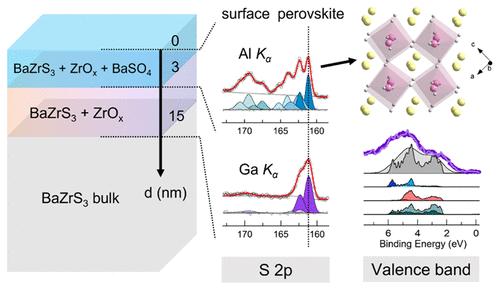当前位置:
X-MOL 学术
›
ACS Appl. Mater. Interfaces
›
论文详情
Our official English website, www.x-mol.net, welcomes your feedback! (Note: you will need to create a separate account there.)
Electronic Structure and Surface Chemistry of BaZrS3 Perovskite Powder and Sputtered Thin Film
ACS Applied Materials & Interfaces ( IF 8.3 ) Pub Date : 2024-07-22 , DOI: 10.1021/acsami.4c06758 Stefania Riva 1 , Soham Mukherjee 1 , Sergei M. Butorin 1 , Corrado Comparotto 2 , Garima Aggarwal 2 , Evelyn Johannesson 1, 3 , Mahmoud Abdel-Hafiez 1, 4 , Jonathan Scragg 2 , Håkan Rensmo 1, 3
ACS Applied Materials & Interfaces ( IF 8.3 ) Pub Date : 2024-07-22 , DOI: 10.1021/acsami.4c06758 Stefania Riva 1 , Soham Mukherjee 1 , Sergei M. Butorin 1 , Corrado Comparotto 2 , Garima Aggarwal 2 , Evelyn Johannesson 1, 3 , Mahmoud Abdel-Hafiez 1, 4 , Jonathan Scragg 2 , Håkan Rensmo 1, 3
Affiliation

|
Chalcogenide perovskites exhibit optoelectronic properties that position them as potential materials in the field of photovoltaics. We report a detailed investigation into the electronic structure and chemical properties of polycrystalline BaZrS3 perovskite powder by X-ray photoelectron spectroscopy, complemented by an analysis of its long- and short-range geometric structures using X-ray diffraction and X-ray absorption spectroscopy. The results obtained for the powdered BaZrS3 are compared to similar measurements on a sputtered polycrystalline BaZrS3 thin film prepared through rapid thermal processing. While bulk characterization confirms the good quality of the powder, depth-profiling achieved by photoelectron spectroscopy utilizing Al Kα (1.487 keV) and Ga Kα (9.25 keV) radiations shows that, regardless of the fabrication method, the oxidation effects extend beyond 10 nm from the sample surface, with zirconium oxides specifically distributing deeper than the oxidized sulfur species. A hard X-ray photoelectron spectroscopy study on the powder and thin film detects signals with minimal contamination contributions and allows for the determination of the valence band maximum position with respect to the Fermi level. Based on these measurements, we establish a correlation between the experimental valence band spectra and the theoretical density of states derived from density functional theory calculations, thereby discerning the orbital constituents involved. Our analysis provides an improved understanding of the electronic structure of BaZrS3 developed through different synthesis protocols by linking it to material geometry, surface chemistry, and the nature of doping. This methodology can thus be adapted for describing electronic structures of chalcogenide perovskite semiconductors in general, a knowledge that is significant for interface engineering and, consequently, for device integration.
中文翻译:

BaZrS3 钙钛矿粉末和溅射薄膜的电子结构和表面化学
硫属化物钙钛矿表现出的光电特性使其成为光伏领域的潜在材料。我们报告了通过 X 射线光电子能谱对多晶 BaZrS 3 钙钛矿粉末的电子结构和化学性质进行了详细研究,并利用 X 射线衍射分析了其长程和短程几何结构和X射线吸收光谱。将粉末状 BaZrS 3 获得的结果与通过快速热处理制备的溅射多晶 BaZrS 3 薄膜的类似测量结果进行比较。虽然整体表征证实了粉末的良好质量,但利用 Al K α (1.487 keV) 和 Ga K α (9.25 keV) 辐射的光电子能谱实现的深度分析表明,无论采用何种制造方法,氧化效应都会从样品表面延伸到 10 nm 以上,其中氧化锆的分布深度比氧化硫物质更深。对粉末和薄膜的硬 X 射线光电子能谱研究可检测污染贡献最小的信号,并可确定相对于费米能级的价带最大位置。基于这些测量,我们建立了实验价带谱与密度泛函理论计算得出的理论态密度之间的相关性,从而辨别所涉及的轨道成分。我们的分析通过将 BaZrS 3 与材料几何形状、表面化学和掺杂性质联系起来,加深了对通过不同合成方案开发的 BaZrS 3 电子结构的理解。 因此,该方法可以适用于描述硫属化物钙钛矿半导体的电子结构,这对于界面工程以及器件集成具有重要意义。
更新日期:2024-07-24
中文翻译:

BaZrS3 钙钛矿粉末和溅射薄膜的电子结构和表面化学
硫属化物钙钛矿表现出的光电特性使其成为光伏领域的潜在材料。我们报告了通过 X 射线光电子能谱对多晶 BaZrS 3 钙钛矿粉末的电子结构和化学性质进行了详细研究,并利用 X 射线衍射分析了其长程和短程几何结构和X射线吸收光谱。将粉末状 BaZrS 3 获得的结果与通过快速热处理制备的溅射多晶 BaZrS 3 薄膜的类似测量结果进行比较。虽然整体表征证实了粉末的良好质量,但利用 Al K α (1.487 keV) 和 Ga K α (9.25 keV) 辐射的光电子能谱实现的深度分析表明,无论采用何种制造方法,氧化效应都会从样品表面延伸到 10 nm 以上,其中氧化锆的分布深度比氧化硫物质更深。对粉末和薄膜的硬 X 射线光电子能谱研究可检测污染贡献最小的信号,并可确定相对于费米能级的价带最大位置。基于这些测量,我们建立了实验价带谱与密度泛函理论计算得出的理论态密度之间的相关性,从而辨别所涉及的轨道成分。我们的分析通过将 BaZrS 3 与材料几何形状、表面化学和掺杂性质联系起来,加深了对通过不同合成方案开发的 BaZrS 3 电子结构的理解。 因此,该方法可以适用于描述硫属化物钙钛矿半导体的电子结构,这对于界面工程以及器件集成具有重要意义。












































 京公网安备 11010802027423号
京公网安备 11010802027423号